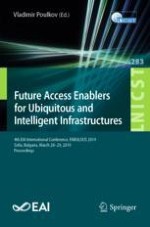2019 | Buch
Future Access Enablers for Ubiquitous and Intelligent Infrastructures
4th EAI International Conference, FABULOUS 2019, Sofia, Bulgaria, March 28-29, 2019, Proceedings
herausgegeben von: Prof. Vladimir Poulkov
Verlag: Springer International Publishing
Buchreihe : Lecture Notes of the Institute for Computer Sciences, Social Informatics and Telecommunications Engineering
